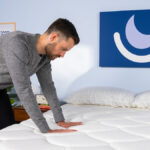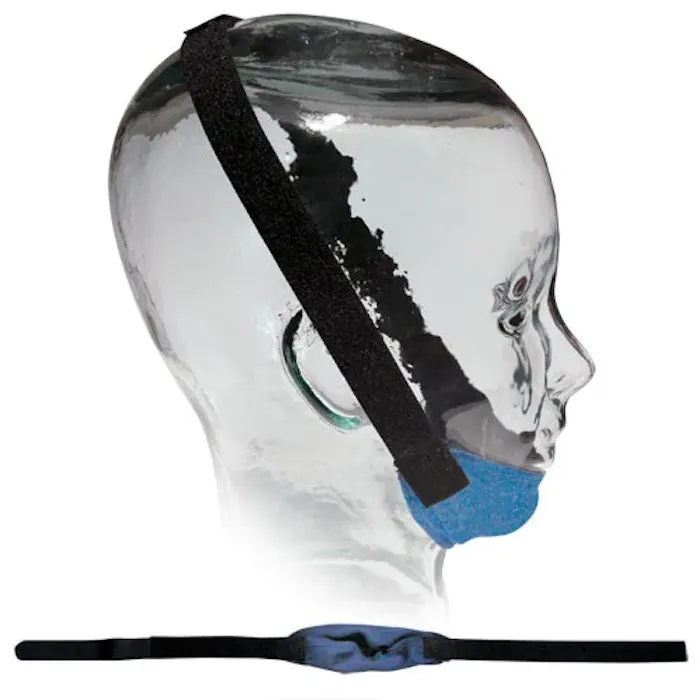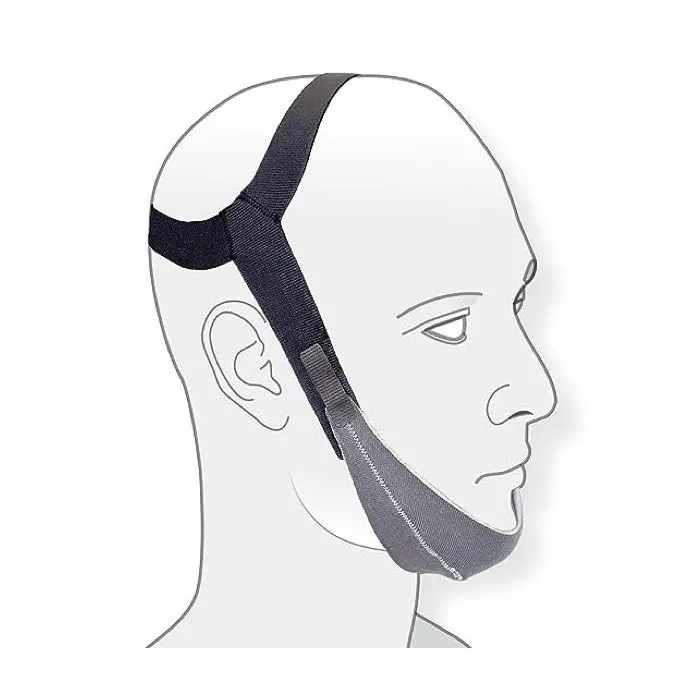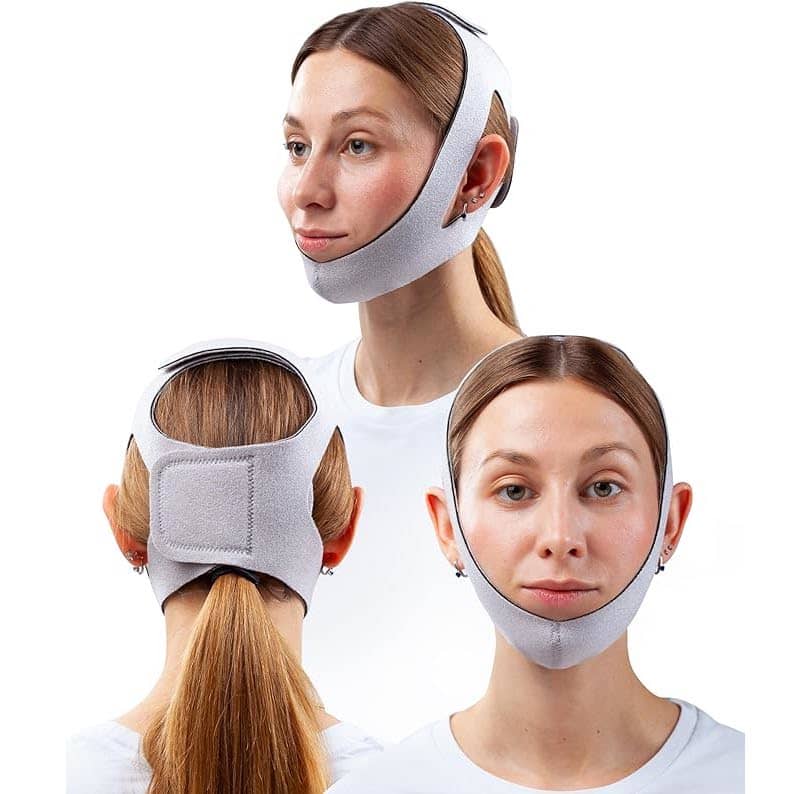Chin straps offer a simple solution to a common problem in continuous positive airway pressure (CPAP) therapy. Often used to treat sleep apnea, CPAP therapy helps keep the upper airway open during sleep by blowing pressurized air into the nose or the nose and mouth. If the mouth opens during sleep, airflow is diverted away from the throat and CPAP therapy is less effective.
A chin strap helps keep the mouth closed so air can’t escape. Research suggests that using a CPAP chin strap may improve therapy by reducing leaks, making it more comfortable to wear the CPAP mask and lowering the number of sleep apnea events that occur during the night.
We’ll examine the best CPAP chin straps on the market today. We’ll also discuss how to know if you need a CPAP chin strap, and how to choose the right model for your needs.
Sleep Doctor’s Picks
Best Overall
Sunset Comfort Chin Strap
Details
Price: $13
Highlights
- Straps can be adjusted to fit most heads
- Minimalist design
- Made using soft, latex-free materials
Drawbacks
- Only comes in one size
- May be more prone to slipping
- Fabric fastener may catch on hair
Sleep Doctor’s Take
The Sunset Comfort Chin Strap features a competitive price-point and a no-frills design that pairs well with most CPAP mask models. A soft pouch cups the chin, and the hook-and-loop fastener on top allows users to adjust the strap length as needed.
The Sunset Comfort Chin Strap consists of a thick elastic band that wraps around the top of the head, with a soft cloth pouch that gently supports the chin and keeps the mouth closed. The chin strap is latex-free and features hook-and-loop fasteners to easily attach at the top of the head.
Why We Like it
The Sunset Comfort Chin Strap has a minimalist design, featuring just one strap that wraps neatly around the head. If you tend to feel claustrophobic during CPAP therapy or if you need a chin strap that’s compatible with bulky CPAP headgear, you may find this design attractive.
Most Comfortable
Snugell Premium Chin Strap
Highlights
- Adjustable straps
- Compatible with long hair
- Very lightweight design
Drawbacks
- May not fit smaller faces
- Not as robust as other models
- May be irritating for those with sensitive skin or facial hair
Sleep Doctor’s Take
The Snugell Premium Chin Strap is made with extremely lightweight materials. It fastens near the face instead of the back of the head, which people with long hair will likely appreciate.
Wrapping around the crown of the head, with a separate attachment to cradle the chin, the Snugell Premium Chin Strap is designed to stay put even when worn with a CPAP mask. The chin strap is made with lightweight, breathable materials and has adjustable straps that let you personalize the fit.
Why We Like it
With its streamlined profile, the Snugell Premium Chin Strap should fit around most CPAP masks and headgear. The straps can be adjusted on either side of the face, so there is less chance that the fastener will get caught in your hair.
Best Adjustable
Brison Anti-Snoring Chin Strap
Highlights
- Snug fit with multiple contact points
- Machine-washable
- Breathable material guards against sweat buildup
Drawbacks
- May not work with certain masks or headgear
- Not designed for heads with a circumference of 27 inches or more
- Full-coverage design may feel warm or claustrophobic to some
Sleep Doctor’s Take
If you’re a fan of chin straps that fit snugly and securely, the Brison Anti-Snoring Chin Strap may be the model for you. This chin strap fits over the sides, top, and back of the head and is made from breathable, machine-washable cloth.
The Brison Anti-Snoring Chin Strap wraps fully around the head, with a large hook-and-loop attachment in the back and another strap on the crown of the head that allows you to fasten it securely. Brison recommends hand-washing or machine-washing the chin strap in cool or warm water, then leaving it to air dry.
Why We Like it
With its thick straps and full-coverage design, the Brison Anti-Snoring Chin Strap is ideal if you’ve had trouble keeping other chin straps in place. The straps are sewn together with low-profile seams that are designed to prevent chafing.
How We Make Our Picks
With many years of experience reviewing sleep products, our team is well poised to deliver accurate and actionable advice to facilitate your search for the best CPAP accessories. We considered all angles when selecting the best chin straps for CPAP, including compatibility with widely used CPAP masks, practical factors like availability and price, and opinions from real users.
What is a CPAP Chin Strap?
A CPAP chin strap is designed to keep the mouth closed and encourage CPAP users to breathe through their nose while they sleep. Doctors may suggest trying a chin strap to improve CPAP therapy for people who use a nasal mask or nasal pillow mask and experience mouth leaks.
Chin straps usually consist of one or more stretchy bands that secure your chin by wrapping around the top or the back of your head or headgear. Most chin straps have a minimalist design that allows them to be worn together with a CPAP mask and headgear.
Do You Need a CPAP Chin Strap?
You may find a chin strap useful if you often experience mouth leak from your CPAP mask, or if you often wake up with a dry mouth when using a CPAP machine.
CPAP air delivered through the nose can escape through the mouth, allowing the airway to collapse and triggering sleep apnea symptoms. Chin straps are designed to fix this problem by sealing the mouth shut, which redirects the air into the upper airway.
A chin strap is not a replacement for CPAP therapy, as it doesn’t keep the airway open. Instead, it works in tandem with CPAP therapy to redirect airflow down your throat instead of allowing air to escape from your mouth.
Manufacturers may also market chin straps as a way to improve snoring, which occurs when muscles in the airway relax and partially block the passage of air. Anti-snoring chin straps have a similar design to CPAP chin straps, and they aren’t designed to keep the airway open. Research does not support the use of a chin strap alone to reduce snoring.
There are many variables that influence whether someone might benefit from a CPAP chin strap, including the type of mask they wear, the shape of their face, and their level of comfort with the CPAP interface.
- You’re a Good Fit if: CPAP chin straps may be a good choice for people who naturally breathe through their mouth while sleeping, especially if mouth breathing is reducing the effectiveness of CPAP therapy. Signs you may benefit from a chin strap include if your CPAP device consistently registers a high leak rate or if you frequently wake up with a dry mouth.
- Who Should Pass on One: A CPAP chin strap isn’t necessary if you use a full-face CPAP mask or if you naturally close your mouth while sleeping. If you breathe through your mouth because of a blocked nose, then it may not be safe or possible for you to use a CPAP chin strap with a nasal mask. Instead, ask your doctor about full-face masks, nasal sprays, or other ways to open up your nasal passages.
What CPAP Masks Work With CPAP Chin Straps?
Both nasal masks and nasal pillow masks can work with a CPAP chin strap. Nasal masks cover the nose and blow air into the nasal passages, while nasal pillow masks have a more minimalist design that slots into the nostrils.
| CPAP Mask Type | What it is | Why it Works With a Chin Strap |
|---|---|---|
| Nasal Mask | Nasal CPAP masks deliver air into the nasal passages via an interface that extends from just above the mouth to the bridge of the nose. A mask frame and head straps help hold the mask in place. | Nasal masks only cover the nose, meaning there is a risk of air leaking from your mouth if you breathe with your mouth open. A chin strap helps keep your mouth closed when wearing a nasal mask. |
| Nasal Pillow Mask | More minimalist than a traditional nasal mask, nasal pillow masks deliver airflow via nasal inserts that slot into the nostrils. Like a nasal mask, a nasal pillow mask also requires straps to keep it in place. | Nasal pillow masks cover very little surface area on the face, which allows them to pair well even with CPAP chin straps that have a larger facial footprint. |
What CPAP Masks Don’t Work With CPAP Chin Straps?
Full-face masks that cover both the nose and mouth are not designed for use with CPAP chin straps since this mask style pushes pressurized air into the mouth.
| CPAP Mask Type | What it is | Why it Doesn’t Work With a Chin Strap |
|---|---|---|
| Full-Face Masks | A full-face CPAP mask blows air into both the mouth and nose. Although full-face masks cover the mouth, this type of mask is less popular because many people find it difficult to get a proper fit. | There’s no need to keep the mouth closed when using a full-face mask, as the mask sits over the mouth and blows air into it. |
| Hybrid Masks | A hybrid mask is similar to a full-face mask in that it delivers pressurized air to both the mouth and nose. However, the nasal portion sits below the nose and seals against the nostrils. | Much like a full-face mask, a hybrid CPAP mask blows air into the mouth, making it unnecessary to keep the mouth closed with a chin strap. |
How to Choose a CPAP Chin Strap
Since a CPAP chin strap is meant to be worn all night, it’s important to find a comfortable model that fits well and doesn’t cause overheating or chafing. Other factors you should consider when buying a CPAP chin strap include price, material quality, and compatibility with your mask and headgear.
CPAP Chin Straps
| Mask Compatibility | To deliver effective CPAP therapy, the chin strap, mask, and headgear all need to fit together on your head. Most chin straps are designed with a low profile to avoid dislodging the CPAP mask and headgear, but it’s always wise to double-check the fit before buying. |
| Sizing and Fit | Chin straps that are too loose may not secure the jaw properly, while those that are too tight may be overly restrictive or leave indentations. Ideally, the chin strap should hold your mouth shut while you sleep but allow you to open your mouth if needed. CPAP chin straps usually have hook-and-loop fasteners and elastic materials that allow you to tailor them somewhat to your head. Some models also come in different sizes, which may be ideal if your head is smaller or larger than average. |
| Temperature Control | If you tend to sleep warm, it’s important to choose a chin strap made with materials that don’t retain heat and moisture. Look for chin straps made with breathable materials like cotton or designs like mesh that boost airflow. |
| Price | Chin straps generally range in price from approximately $10 to $20 and usually last about six months before needing to be replaced. Since there’s not a huge difference in prices, comfort may ultimately be more important when choosing a CPAP chin strap. |
| Material Quality | Higher-quality materials are less likely to prematurely wear out or lose their elasticity. They may also be easier to clean and more comfortable, especially for people with sensitive skin. Common materials found in a CPAP chin strap include spandex, polyester, cotton, and nylon. Most manufacturers advertise whether the chin strap is latex-free. |
| Design | CPAP chin straps range from simple one-band pieces to more complex designs that wrap around the top or back of the head. You might prefer a simpler design if you tend to feel claustrophobic, or if the chin strap is chafing against the back of your hair. Conversely, active sleepers and those who have trouble keeping the chin strap in place might prefer a design that offers more coverage. |
Tips for Wearing a CPAP Chin Strap
Most CPAP chin straps are designed to be worn underneath the CPAP mask. Generally, you’ll need to put on your chin strap and adjust the straps, ensuring the strap applies gentle pressure to keep the jaw closed without feeling uncomfortable. Then, place your CPAP mask over the chin strap and adjust the straps.
Finding the right fit for your CPAP chin strap and mask may depend on the model, so check the user guide to see if the chin strap is meant to go over or under the mask.
How to Wear Your Hair With a CPAP Chin Strap
If you have long hair, consider putting your hair in a ponytail while donning and adjusting your CPAP mask. Since most chin straps have hook-and-loop parts that can get stuck in your hair, it’s best to avoid having loose hair when making adjustments.
Once the chin strap and mask are securely fastened, you should be able to let out your hair through the gaps in the strap to sleep more comfortably. If you still find your hair catching on the hook-and-loop parts, you may want to wear a thin hair covering.
How to Clean a CPAP Chin Strap
Most CPAP chin straps can be washed weekly with mild soap and warm water. Some models can be machine-washed, though we recommend closing the hook-and-loop fastener and putting the chin strap in a laundry bag to avoid stretching out the elastic parts. Check the user guide for care instructions specific to your model.
Try to avoid exposing CPAP chin straps to hot temperatures. It’s best to air dry your chin strap away from direct sunlight instead of putting it in the dryer.
Frequently Asked Questions
You don’t need a prescription to buy a CPAP chin strap. While you do need a prescription to buy a CPAP machine or a CPAP mask, most other CPAP accessories can be purchased without a prescription.
Medicare covers the cost of a new chin strap every six months when it’s used as part of your CPAP therapy. Coverage under state Medicaid and other health insurance plans may vary.
CPAP chin straps usually need replacing every six months. You should replace your chin strap if the elastic has stretched out or if the straps no longer stay fastened.
Facial oils can wear down chin strap materials, but rough washing or stretching can also take their toll. To keep your chin strap in top shape for as long as possible, keep it clean by gently hand-washing it on a regular basis.
Ask the Sleep Doctor
Have questions about sleep? Submit them here! We use your questions to help us decide topics for articles, videos, and newsletters. We try to answer as many questions as possible. You can also send us an email. Please note, we cannot provide specific medical advice, and always recommend you contact your doctor for any medical matters.





